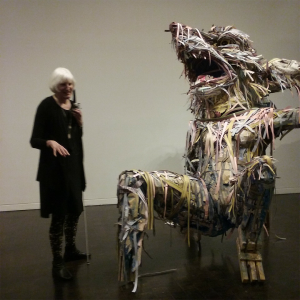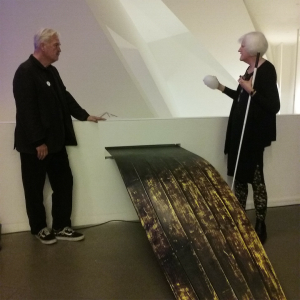One of the many welcome features of the Jewish Folktales Retold exhibition at the Contemporary Jewish Museum in San Francisco are the experimental access and interpretive materials created in collaboration with writer and professor Georgina Kleege.

Georgina is a leading scholar working at the intersection between blindness and visual art. She is also the blind daughter of two visual artists. A professor of English and Disability Studies at UC Berkeley, Georgina has expanded the field of audio description through her practice.
The exhibition closes on Sunday January 28 and I urge everyone to visit and engage with the varied and magical works in the show, all inspired by one or more stories from Jewish folklore tradition. Folktales often portray the lives of ordinary people and usually feature magical or divine interventions that are often embellished or elaborated upon. While the stories have been re-told for centuries their basic linear form has remained the same. The exhibition casts the artist as storyteller or maggid, and powerful, complex tales are given tangible form and surprising re-interpretations by 16 selected contemporary artists, commissioned by the museum.
What are Haptic Encounters?
The word haptic refers to our sense of touch and these days is often used to describe the vibrating feedback functions on smartphones, touch tablets and virtual reality devices. Here though, we are far from the digital realm. While all other visitors (including those who are blind) may not touch the commissioned artworks, Georgina has engaged with six of the exhibits at length, and captured her experiences as she met each one.
Georgina’s role as maggid
As a writer, Georgina’s immersion in the practice of story-telling provides us with an extra maggid, a voice directly connecting us to the art. Through her artful encounters, touching and grappling with the scale and nature of each piece, our own experience is better. Her journey is sensory, enticing and decidedly not visual, and makes us all, as sighted or non-sighted visitors, slow down and spend more time with each art work. Like slow food, slow art is a very satisfying experience that has immense staying power.
Access elements
At six of the clearly marked listening stations with recordings of each folk tale, there are also audio files of these Haptic Encounters by Georgina. Videos, audio and transcripts of the encounters are also available online. Braille booklets of all wall text and artist labels are available at the reception desk, and large print booklets from a dispenser at the entrance of the gallery. Transcripts of all audio material from listening stations are also available, as well as a tactile gallery map developed in partnership with Lighthouse for the Blind and Visually Impaired.
For a taste of the video material please check out: Introduction to Haptic Encounters with Georgina Kleege

An evening at the museum
In December 2017, I spent a wonderful evening at the museum with a crowd of blind, visually impaired and other disabled visitors, led by Georgina and Cecile Puretz, Access and Community Engagement Manager of the of the CJM for a group exploration of Haptic Encounters. Our tour began in the lobby with an invitation to explore the architect’s model of the museum and an introduction by Cecile to the conceptual scope of the exhibition, and the museum’s determination to expand access for blind and visually impaired visitors. My photos of the evening were mostly out of focus so I only have a few to share here but I hope it will be enough to excite you about the work going on at the Contemporary Jewish Museum, and the future possibilities for tactile explorations by other museums.
I noticed that while guiding us around the show, Georgina also used the word proprioception to expand our understanding of her process. Proprioception refers to the unconscious perception of movement and spatial orientation arising from stimuli within the body itself. As Georgina explained, through her physical exploration of these large and varied sculptures, some invited a light, delicate touch, while others seemed to ask for a more vigorous handling. All very useful information for us, as visitors, who are not allowed to touch. The trolley of materials samples used by artists that traveled along with us was very useful and helped to understand the nature of each sculpture as we journeyed through.

Why are these encounters valuable for everyone?
These are not stuffy, academic adventures and show how much the disability community can contribute to the field of museum interpretation. Georgina’s voice was that of a curious, playful, informed visitor who also risked making herself vulnerable with honest responses and comments. Similar projects could help many visitors feel welcome and relaxed in their own reactions to new and challenging work.
Within the limits of what is possible, the experience has provoked much thought about who gets to touch and who doesn’t. Only six encounters are on offer and so this is not a full equivalence for blind or visually impaired people, where every element is accessible. Nevertheless it is a welcome step, and left me wondering how to encourage artists to make work that is primarily tactile and robust. Does it really matter if we all touch an artwork that is due to be destroyed anyway?
Let’s keep pushing the boundaries of this kind of work!!!!
Useful links:
Haptic Encounters within Jewish Folktales Catalog
Jewish Folktales retold: The Artist as Maggid at the CJM
Digital Catalog for Jewish Folktales Exhibition
VIDEO: Introduction to Haptic Encounters with Georgina Kleege
Georgina has a new book out called “More than Meets the Eye: What Blindness Brings to Art” available on Amazon and all good booksellers.